132+ Literary Devices Examples
Literary devices are powerful tools used by writers to enhance their storytelling and make their work more engaging and meaningful. These devices, such as metaphors, similes, alliteration, and symbolism, help to convey deeper meanings, create vivid imagery, and evoke emotions in the reader. Whether in novels, poetry, or plays, literary devices allow authors to express complex ideas in a clear and compelling way, making their writing memorable and impactful. Understanding these tools can enrich your reading experience and improve your own writing skills.
What are Literary Devices ?

Common Literary Devices List
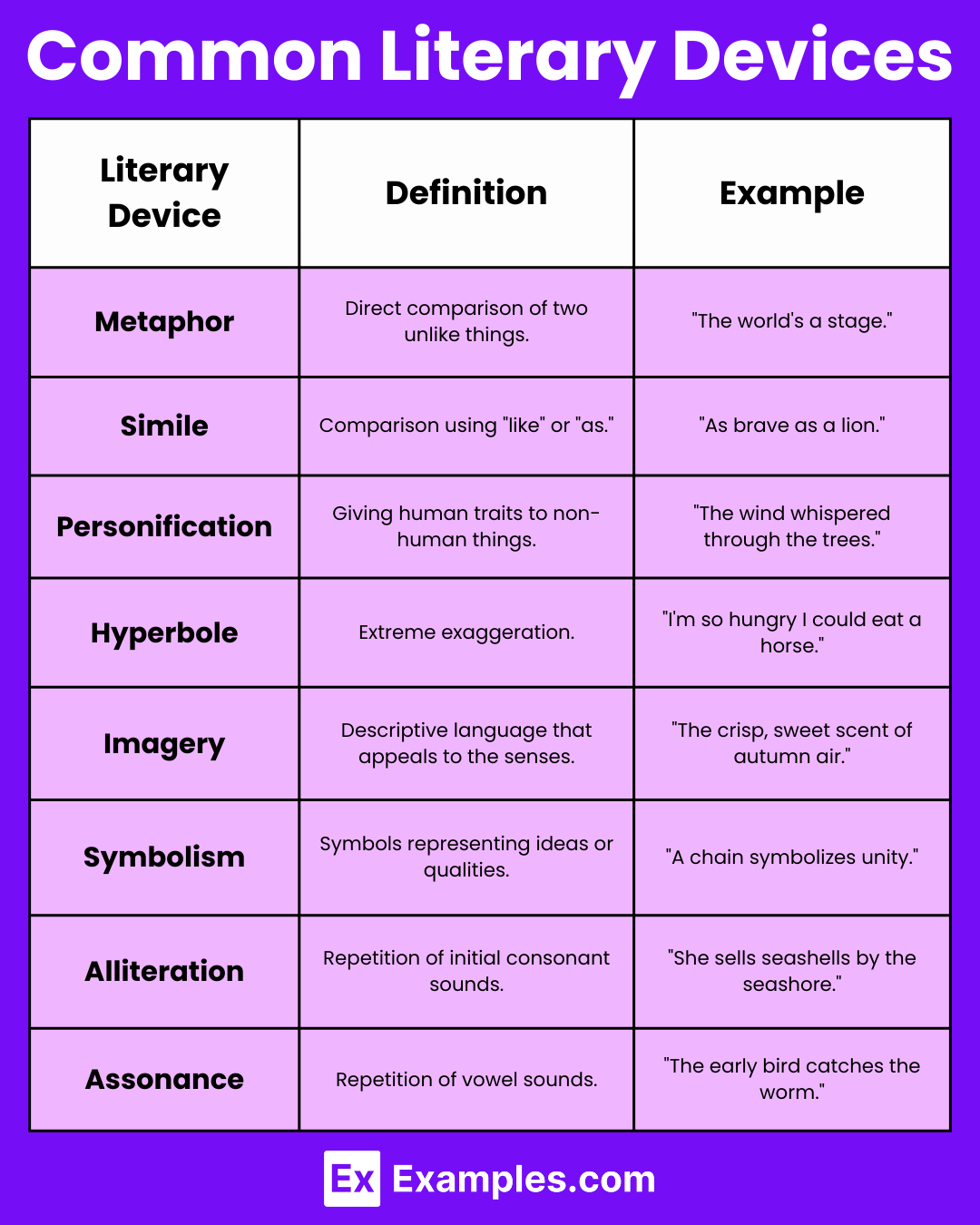
1. Metaphor
A metaphor is a figure of speech that directly compares two unlike things, suggesting they are alike in a significant way. It’s used to symbolize or represent another concept, often to provide a more vivid or imaginative description.
Example of metaphor: “Her smile is a ray of sunshine.”
To use a metaphor, identify a commonality between two different things and state that one thing is the other. Metaphors are effective in creating strong imagery and conveying complex ideas simply.
2. Simile
A simile, like a metaphor, compares two different things but does so explicitly using “like” or “as.” It helps in painting a detailed picture in the reader’s mind by highlighting similarities between two entities.
Example of Simile: “He fights like a lion.”
Use similes to make descriptions more vivid and understandable. Incorporate “like” or “as” in your sentence to draw a direct comparison, enhancing the imagery of your writing.
3. Personification
Personification is a literary device where human qualities are attributed to animals, objects, or ideas. It involves giving these non-human entities human-like emotions, behaviors, or characteristics.
Example of Personification: “The wind whispered through the trees.”
To use personification, assign human traits or actions to inanimate objects or abstract concepts. This is effective in making descriptions more dynamic and relatable, and in animating the non-living elements of your narrative.
4. Alliteration
Alliteration is a literary device where the same consonant sound is repeated at the beginning of closely connected words. It’s often used to create rhythm, enhance mood, or emphasize certain words or themes within a text.
“She sells seashells by the seashore.”
To use alliteration effectively, identify the mood or tone you wish to set in your writing. Choose words that share the same starting consonant sound and place them close together in your sentence. This device works well in poetry, tongue twisters, and to add a musical quality to prose.
5. Hyperbole
Hyperbole is an exaggerated statement not meant to be taken literally, but used for emphasis or effect. It’s a way to convey strong feelings or create a strong impression but is not intended to be taken as a factual statement.
“I’m so hungry I could eat a horse.”
When you want to emphasize a point or add humor, consider using hyperbole. Exaggerate the characteristics or effects of an object or situation to a highly improbable level. However, it’s important to ensure that the exaggeration remains obvious to avoid misleading the reader.
6. Onomatopoeia
Onomatopoeia refers to words that imitate the natural sounds associated with actions or objects. This device can create more immersive, vivid, and expressive writing, allowing the reader to hear the sounds through the words.
“The bees buzzed in the garden.”
Use onomatopoeia when you wish to add auditory imagery to your writing. Identify the sounds present in the scene you are describing and select words that mimic those sounds. Onomatopoeia is particularly effective in creating a sensory experience in narratives and poems.
7. Irony
Irony is a literary device where words are used in such a way that their intended meaning is different from the actual meaning of the words. It may also be a situation that ends up in quite a different way than what is generally anticipated. Irony is typically used for humorous or emphatic effect.
“A fire station burns down.”
To use irony effectively, identify a situation or use language where the outcome is the opposite of what is expected. It works well to convey sarcasm, satire, or to create a twist in the narrative, adding depth and complexity to the story.
8. Foreshadowing
Foreshadowing is a literary device used to give an indication or hint of what is to come later in the story. It often appears at the beginning of a story, or the start of a chapter, and helps the reader develop expectations about the upcoming events.
“A character finds a mysterious key early in the story, which unlocks a secret room later.”
Incorporate subtle hints or clues in your narrative that suggest future events. This builds suspense and anticipation, keeping the reader engaged and curious about how the story will unfold.
9. Imagery
Imagery involves using descriptive language to create a vivid mental picture for the reader, often appealing to the five senses. It enhances the reader’s experience by making the setting and characters more alive and realistic.
“The sunset painted the sky with hues of pink and orange.”
Use detailed and sensory language to paint a picture in the reader’s mind. Describe scenes, objects, or feelings with rich, evocative language that makes the reader feel as if they are part of the setting or experience.
10. Symbolism
Symbolism is a literary device where symbols are used to represent ideas or qualities. It involves using an object, person, situation, or action to convey a deeper, often more abstract meaning.
“A dove is used to represent peace.”
To use symbolism effectively, choose an object or element in your narrative that can naturally and consistently represent a deeper concept or theme. The symbol should enrich the story and offer insights without being overly obvious.
11. Flashback
Flashback is a technique that interrupts the chronological flow of a narrative to revisit earlier events. This device provides background information, context, or character motivation.
A classic example is in Harper Lee’s “To Kill a Mockingbird,” where the adult narrator, Scout, reflects on her childhood experiences, offering depth and perspective to the story.
Use flashbacks to reveal critical information or backstory that enhances the reader’s understanding of the current situation or the characters’ motivations. Ensure the transition to and from the flashback is smooth to maintain narrative coherence.
12. Allegory
Allegory is a narrative that operates on two levels: the literal and the symbolic. Characters, events, and settings represent abstract ideas or moral qualities.
George Orwell’s “Animal Farm” is an allegory for the Russian Revolution, with farm animals symbolizing different figures from the revolution.
When writing an allegory, develop your story to mirror the larger concepts or messages you wish to convey. Each element of your narrative should correlate to an aspect of the allegory, ensuring consistency and clarity in your symbolism throughout the story.
13. Oxymoron
An oxymoron is a figure of speech that combines contradictory terms in a brief phrase to create a paradoxical effect. It’s often used to reveal a deeper or hidden truth through contradiction.
“Jumbo shrimp” or “deafening silence.”
To effectively use an oxymoron in your writing, look for opportunities where contrasting ideas can convey a complex or nuanced meaning. Oxymorons can add flavor to your language, create a memorable impact, and provoke thought. They work well in creative writing, poetry, and even in persuasive writing where emphasizing the complexity of an issue is key.
14. Euphemism
Euphemism involves using a milder or less direct word or phrase to describe something unpleasant or offensive, making it more palatable. It’s a way to address sensitive topics tactfully.
Saying “passed away” instead of “died.”
Euphemisms are useful in delicate situations where direct language might be too harsh or inappropriate. They can be employed in formal writing, sensitive discussions, and when addressing topics related to health, death, or other potentially upsetting subjects. The key is to balance clarity with sensitivity.
15. Anaphora
Anaphora is a rhetorical device that involves the repetition of a word or phrase at the beginning of successive clauses or sentences. This technique is used for emphasis and to create a rhythmic, persuasive impact.
“We shall fight on the beaches, we shall fight on the landing grounds, we shall fight in the fields.”
Anaphora can be used in speeches, poetry, and persuasive writing to emphasize a point and create a sense of urgency or importance. It’s effective in rallying emotions and highlighting key themes. Use it to draw the reader’s or listener’s attention to a central idea or to build momentum in your narrative.
Literary Device in Poetry
- Anaphora
- Conceit
- Apostrophe
- Metonymy/Synecdoche
- Enjambment
- Zeugma
- Repetition
- Rhyme
- Juxtaposition
- Consonance/Assonance
- Euphony/Cacophony
- Meter
- Ambiguity
- Catharsis
- Motif
- Pathetic Fallacy
Literary Devices In Pros
- Parallel Plot
- Foil
- Diction
- Mood
- Ekphrasis
- In Media Res
- Dramatic Irony
- Vignette
- Flashback
- Soliloquy
- Narrative
- Parable
- Pastiche
- Zoomorphism
Repetition Literary Devices
- Anadiplosis
- Antanaclasis
- Antimetabole
- Antistrophe
- Chiasmus
- Epanalepsis
- Epimone
- Epizeuxis
- Polyptoton
- Symploce
- Epigraph
- Tautology
Dialogue Literary Devices
Word Play Literary Devices
- Anthimeria
- Double Entendre
- Kenning
- Malapropism
- Metalepsis
- Oxymoron
- Palindrome
- Paraprosdokian
- Portmanteau
- Spoonerism
- Homophone
Parallelism Literary Devices
- Grammatical parallelism
- Rhetorical parallelism
- Synthetic parallelism
- Antithetical parallelism
- Synonymous parallelism
Literary Devices for Kids
- Simile – “The clouds were as fluffy as cotton candy.”
- Metaphor – “The stars are diamonds in the sky.”
- Alliteration – “Silly Sammy swiftly sailed the seas.”
- Personification – “The flowers danced in the breeze.”
- Onomatopoeia – “The bell rang, ding-dong!”
- Hyperbole – “I’ve told you a million times!”
- Imagery – “The golden sun set behind the sparkling blue ocean.”
- Repetition – “Rain, rain, go away, come again another day.”
- Rhyme – “The cat sat on a hat.”
- Idiom – “It’s raining cats and dogs.”
Literary Devices for Descriptive Writing
- Simile – “Her hair shone like golden threads.”
- Metaphor – “The room was a furnace in the summer.”
- Personification – “The trees whispered secrets in the wind.”
- Imagery – “The crisp smell of fresh bread filled the air.”
- Alliteration – “The bright, bold balloons bounced on the breeze.”
- Hyperbole – “I’ve been waiting for eternity!”
- Onomatopoeia – “The leaves crunched underfoot.”
- Juxtaposition – “The quiet library contrasted sharply with the noisy streets outside.”
- Symbolism – “The red rose symbolized her love for him.”
- Oxymoron – “The silent scream echoed in the dark.”
Literary Devices for Argumentative Essay
- Ethos – “As a doctor, I believe that this treatment is essential.”
- Pathos – “Imagine the heartbreak of losing a loved one to a preventable disease.”
- Logos – “Studies show that exercise improves mental health by 20%.”
- Rhetorical Question – “How can we ignore the suffering of others?”
- Anecdote – “I once witnessed a child struggle to learn because of a lack of resources.”
- Allusion – “This policy is a modern-day version of the ‘American Dream.’”
- Contrast – “While some argue for greater control, others demand freedom of choice.”
- Repetition – “We need change. We need action. We need hope.”
- Appeal to Authority – “Experts agree that renewable energy is the future.”
- Counterargument – “Some may argue against this proposal, but here’s why it’s beneficial.”
Literary Devices for Characterization
- Direct Characterization – “She was a kind-hearted woman who always helped others.”
- Indirect Characterization – “His clenched fists and furrowed brow told me he was angry.”
- Dialogue – “‘I’ll never give up,’ she said, her voice full of determination.”
- Actions – “He spent hours volunteering at the shelter every weekend.”
- Appearance – “Her eyes sparkled with excitement and her smile was bright.”
- Thoughts – “He couldn’t stop thinking about the mistake he had made.”
- Reactions of Others – “Everyone admired his courage, especially during difficult times.”
- Symbolism – “The old watch he wore symbolized his love for his late father.”
- Foil – “While John was calm and reserved, Paul was loud and impulsive.”
- Conflict – “Her struggle to balance work and family life showed her inner turmoil.”
Rhetorical Devices
- Kairos
- Ethos
- Logos
- Pathos
- Anacoluthon
- Antithesis
- Asyndeton
- Hypallage
- Hyperbaton
- Hypotaxis
- Parataxis
- Polysyndeton
- Synesis
- Accismus
- Anecdote
- Antanagoge
- Aporia
- Bdelygmia
- Enthymeme
- Hypophora
- Procatalepsis
- Reductio ad Absurdum
- Syllogism
- Adynaton
- Amplification
- Antiphrasis
- Asterismos
- Litotes
- Meiosis
- Metanoia
- Paralipsis
- Overstatement
- Tmesis
- Adnomination
- Aposiopesis
- Circumlocution
- Dysphemism
- Ellipsis
- Isocolon
- Pleonasm
List of Literary Devices

Literary Devices Techniques and Elements
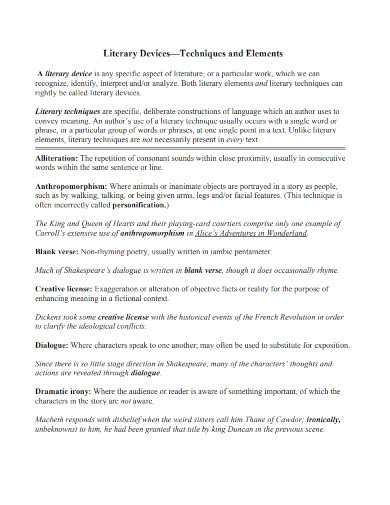
Literary Devices and Terms
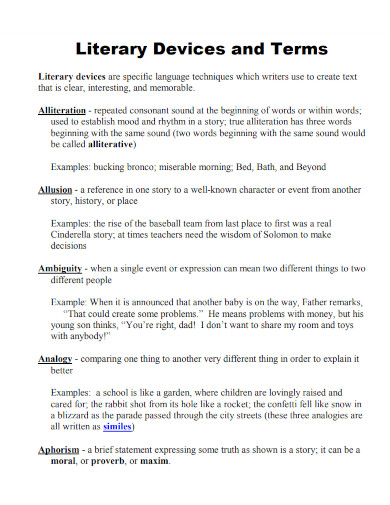
Literary Devices in Literature
- Direct Characterization – “She was a kind-hearted woman who always helped others.”
- Indirect Characterization – “His clenched fists and furrowed brow told me he was angry.”
- Dialogue – “‘I’ll never give up,’ she said, her voice full of determination.”
- Actions – “He spent hours volunteering at the shelter every weekend.”
- Appearance – “Her eyes sparkled with excitement and her smile was bright.”
- Thoughts – “He couldn’t stop thinking about the mistake he had made.”
- Reactions of Others – “Everyone admired his courage, especially during difficult times.”
- Symbolism – “The old watch he wore symbolized his love for his late father.”
- Foil – “While John was calm and reserved, Paul was loud and impulsive.”
- Conflict – “Her struggle to balance work and family life showed her inner turmoil.”
Principal Rhetorical and Literary Devices

Samples Literary Devices
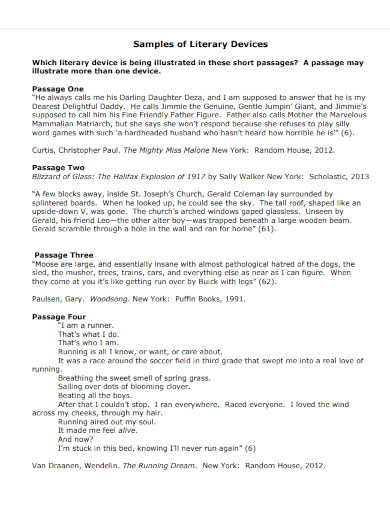
Literary Devices Essay Rubric
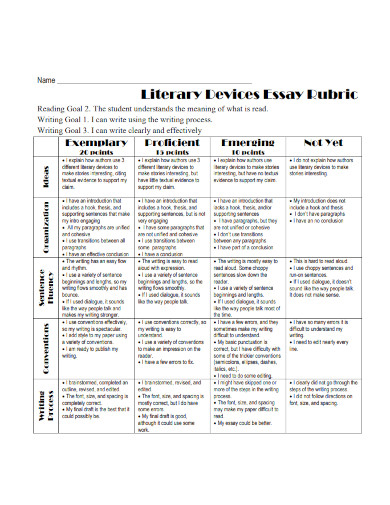
Rhetorical Literary Devices List
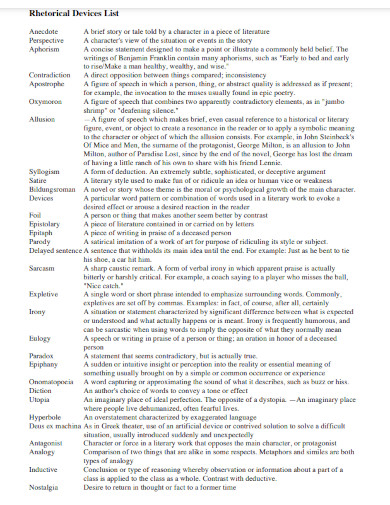
How to Use Literary Devices

A well-placed literary device can improve the overall style of your writing. If you need a reference for the types of literary devices like alliteration, symbolism, imagery, and parallelism, you may refer to this list of literary devices. But if you want to know more about the concept of literary devices you may use any of the literary device cheat sheets, samples, lists, strategies, and literary elements on the links above.
1. Choose the Type of Literary Device you Want to Use
Begin by selecting the type of literary device you want to use in your writing. This will dictate the structure and the words you will use in your text.
2.Plan Out the Literary Device you are Going to Use
After you have selected the literary device you are using, you must plan out how you are going to insert or incorporate it into your text. For example, if you are planning on using a simile to describe an object, you must make sure the simile is relevant to the context of the text.
3.Depending on the Type, Insert the Literary Device into the Text
When you have finished planning out what and how you are going to use the chosen literary device, you must insert and write it into your text. Note, that if the literary device is not placed or paced correctly, it will make the text less readable.
4. Repeat Steps One to Three, Until you are Satisfied
After you have finished steps one to three, you may repeat them until you have placed enough literary devices into your text. Just note, that too many literary devices in single writing or text, will confuse the reader and break the pace.
How to Identify Literary Devices
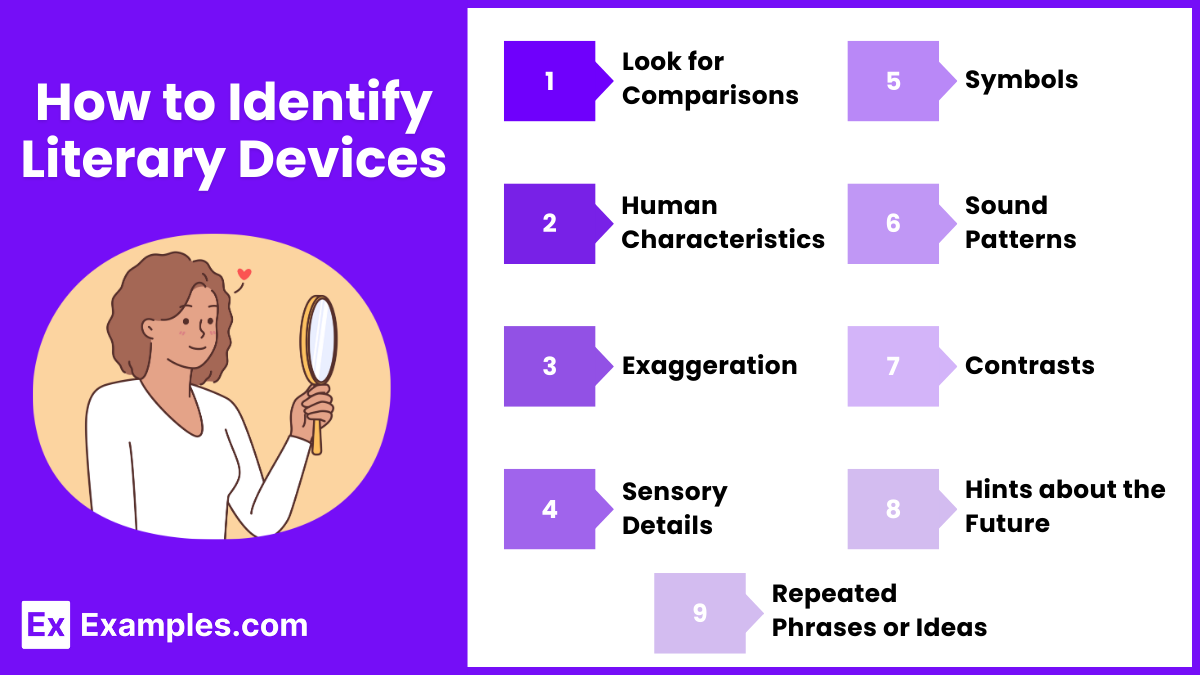
- Look for Comparisons: If something is being compared to something else, especially using “like” or “as,” it’s likely a simile. Without “like” or “as,” it could be a metaphor.
- Human Characteristics: When non-human objects or ideas are described as if they have human qualities or actions, it’s personification.
- Exaggeration: If a statement seems too extreme to be true, it’s probably hyperbole, used for emphasis or humor.
- Sensory Details: Descriptions that appeal strongly to the senses (sight, sound, smell, touch, taste) are using imagery to create vivid pictures.
- Symbols: Objects or actions that seem to have a deeper meaning or represent something else signal the use of symbolism.
- Sound Patterns: Repetition of sounds at the beginning of words is alliteration. Repetition of vowel sounds in the middle of words indicates assonance.
- Contrasts: When the reality is opposite to what is expected or stated, it’s irony. This can occur in what characters say, the story’s events, or between the audience’s knowledge and the characters’.
- Hints about the Future: Clues or hints that suggest what will happen later in the story are examples of foreshadowing.
- Repeated Phrases or Ideas: Repeating specific phrases, ideas, or themes might indicate an important motif or message in the text.
FAQs
What is the effect of a literary device?
Literary devices allow the text to have a certain depth that would otherwise be lost without the presence of a literary device. These devices allow the reader to not only make connections with symbolism but they will also have a deeper appreciation for the text. Through the author’s strategic usage of literary devices, the reader is allowed to make their connections on their own which can lead to the organic growth of their reader’s interest in the text. Literary devices will also increase the overall style and substance of the text it is used on.
What happens if we do not use any literary devices?
Literary devices in a text or narrative are akin to clothes being worn by a person. This means that literary devices make will make the text, book, essay, or story more tasteful, and interesting, and have more personality. If the author does not use any literary devices in their text, it may become bland, and tasteless which are not conducive to maintaining the interest of the reader in both the text and the author’s works.
What happens if we overuse literary devices?
Literary devices are like spices, in that the proper amount can make a text very tasteful and stylish. The same is true when you add too many spices to a dish, the more literary devices used in the text can confuse the reader, thus diminishing interest and readability. This is because literary devices provide more style than substance. Not only that but having too many literary devices in the text will lead to diminishing returns, which will end up causing more harm than good.



